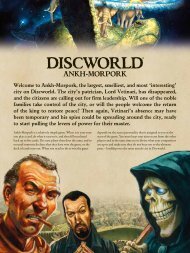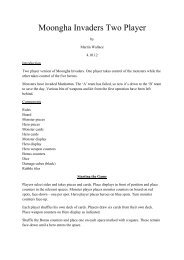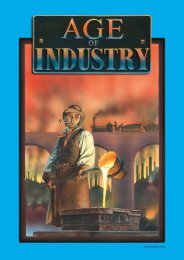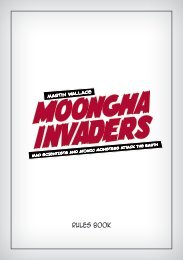Steam Barons Rules (PDF) - Treefrog Games
Steam Barons Rules (PDF) - Treefrog Games
Steam Barons Rules (PDF) - Treefrog Games
Create successful ePaper yourself
Turn your PDF publications into a flip-book with our unique Google optimized e-Paper software.
‘<strong>Steam</strong> <strong>Barons</strong> ’ is an expansion designed to work<br />
with <strong>Steam</strong> . A double-sided map is included,<br />
showing the eastern half of the USA and parts<br />
of Canada on one side and northern England<br />
on the other. These maps can be used with the<br />
base or standard rules. In addition there are new<br />
special rules that combine some of the standard<br />
rules with a stock-market system.<br />
If you choose to play these maps using the base or<br />
standard rules then it is strongly recommended that<br />
you do so with five or six players.<br />
If you choose to play using the stock-market rules<br />
then you will find that the maps can be enjoyed with<br />
two, three, four, five, or six players.<br />
The wooden train pieces are intended to be used<br />
with the stock-market rules to mark ownership of<br />
track links but there is no reason why you cannot<br />
also use them for the same purpose in the base<br />
and standard games.<br />
Contents<br />
x 24 x 24 x 24<br />
x 24<br />
x 24<br />
x 24<br />
Track ownership markers<br />
x 26 x 6<br />
16 black<br />
goods cubes<br />
1 first player<br />
marker<br />
38 Railway track<br />
tiles<br />
32 money tokens 6 Company displays<br />
1 double-sided game board<br />
1 rules booklet<br />
1 Stock-market game card<br />
1
Base and standard rules – both maps<br />
These two maps have been designed to work best with five or six<br />
players. As a result additional track pieces have been provided.<br />
Please add these track pieces to the set included with your original<br />
copy of <strong>Steam</strong>.<br />
Set-up<br />
Add the sixteen black cubes to the standard goods cubes in the bag.<br />
Ignore the printed numbers on the city hexes and place two goods<br />
cubes in each city. Place two cubes in each Goods Supply space.<br />
Black goods cubes<br />
Black goods cubes can only be delivered to the black cities printed on<br />
the map. Grey goods cubes can only be delivered to grey New City tiles.<br />
Eastern US map only<br />
The following rules apply for the<br />
base, standard, and stock-market<br />
versions of <strong>Steam</strong>.<br />
When building track you can do<br />
so only from a city marked with a<br />
port symbol, a city connected by<br />
track to a port city (the track can<br />
belong to any player), or from<br />
track that you already have on<br />
the board.<br />
Some cities are adjacent to each other.<br />
These can be connected by placing one of<br />
your tokens on the connecting track symbol.<br />
It costs you $3 to do so and counts as<br />
placing one track tile.<br />
The map artwork varies from the original<br />
Mayfair edition. Also, mountains have been<br />
added as a new terrain feature. Hills still<br />
cost $2 extra to build in, while mountains<br />
cost $3 extra to build in.<br />
Connecting<br />
track symbol<br />
Other than these changes all the normal rules for base or standard<br />
<strong>Steam</strong> TM are used.<br />
<strong>Steam</strong> <strong>Barons</strong> stock-market rules<br />
Port symbol<br />
Hill hex<br />
Mountain hex<br />
In the <strong>Steam</strong> <strong>Barons</strong> stock-market game players take on the role of<br />
investors in the various rail companies and endeavour to make shrewd<br />
investments in these companies.<br />
A company will be under the control of the player who owns the most<br />
shares in it. Each turn the relative performance of the companies will<br />
be reflected in changes to their share prices. Players need to invest in<br />
the right company at the right time and divest themselves of shares in<br />
companies before disaster strikes.<br />
In this version of the game you should use the train pieces provided to<br />
mark ownership of links. The coloured player tokens are now used as<br />
company shares and to record a company’s share price and mark its<br />
place in the order of play. Please use the orange, green, brown, natural<br />
wood, black, and white player tokens for these purposes.<br />
Note that while the same coins are used for player money and company<br />
money these are not directly interchangeable. Money within a company<br />
is a magnitude larger than the same amount held by a player.<br />
Starting the Game<br />
The stock-market game card should be<br />
placed by the side of the board.<br />
Add the sixteen black goods cubes to the<br />
mix of cubes in the bag.<br />
Randomly draw and place a number of<br />
goods cubes in each city equal to the<br />
value in the city.<br />
Randomly draw and place one goods<br />
cube in each town hex.<br />
Do not place any goods cubes in the<br />
Goods Supply spaces.<br />
Now remove all of the grey goods cubes from cities and towns and<br />
place them back in the game box.<br />
After you have seeded the board with goods cubes remove all of the<br />
remaining cubes from the bag and place them back in the game box.<br />
Place the six Company displays by the<br />
side of the board. Place $5 on each<br />
display (the game starts with each<br />
company having issued one share).<br />
If you are playing the northern England<br />
map then each company display starts<br />
with six share tokens on it. If you are playing the Eastern US map then<br />
each company display starts with eight share tokens on it.<br />
Place one company share token for each company in the Available<br />
Shares box, which can be found on the Stock-market game card.<br />
Mark the share price for each company on the Share Price track using a<br />
spare company token. All companies start with a share price of $5.<br />
Place one spare company token for each company on the zero space of<br />
the Victory Point track on the board. This track will be used to record<br />
each company’s performance during each turn.<br />
Place one spare company token<br />
for each company in the cloth bag.<br />
Draw one token at a time. The<br />
order in which tokens are drawn<br />
determines the order of play for the companies. Mark this order on the<br />
Order of Play track.<br />
With two players each player starts with $40. With three players each<br />
player starts with $30. With four players each player starts with $25.<br />
With five or six players each player starts with $20.<br />
Randomly determine the first player and give that player the first<br />
player marker.<br />
Place the turn marker in the first space of the Game Turn track.<br />
2
Playing the Game<br />
The game will be played over five turns. Each game turn consists of<br />
the following phases:<br />
1. Buy shares<br />
2. Build track<br />
3. Move goods<br />
4. Dividends<br />
5. Sell shares<br />
6. Bankruptcies<br />
7. Company order of play<br />
8. End of turn<br />
Phase one: Buy shares<br />
All players now have the opportunity to buy shares in companies. The<br />
only shares available to be purchased are those in the Available Shares<br />
box. Players cannot buy shares presently located on company displays.<br />
The order in which available shares are offered up for sale is the same<br />
as the company order of play, as shown on the Order of Play track. The<br />
price at which shares will be sold is determined by auction. One auction<br />
will be held for each company, with some or all of the shares in that<br />
company being sold at the final auction price. If there are no shares<br />
for a particular company in the Available Shares box then no auction<br />
is held for that company.<br />
Each auction begins with the player holding the first player marker<br />
having the opportunity to make the first bid. The order of bidding goes<br />
clockwise from the first player. A player can choose to pass rather than<br />
make a bid. The first bid made must match or exceed the present share<br />
price of the given company. If the share price of a company is zero then<br />
the lowest bid possible is $1. All ensuing bids must be higher than<br />
the previous bid. If a player passes he cannot bid again in the present<br />
auction. Bidding continues until there is a single highest bid.<br />
The player who has made the highest bid must now buy at least one<br />
share at the price he bid. He can choose to buy more than one available<br />
share, paying the amount bid for each share that he buys. It is possible<br />
for a player to buy all of the available shares in a company.<br />
Now, going clockwise from the player who just purchased shares, each<br />
remaining player has the opportunity to buy any remaining shares in<br />
the given company. The price per share is the same as that paid by the<br />
first player to buy shares. A player can choose to buy more than one<br />
available share. Once each player has had the opportunity to buy shares<br />
play progresses to the auction of the next company’s available shares,<br />
i.e. a player never has a second opportunity to buy shares in a single<br />
game turn.<br />
All money paid for shares should be paid into the bank. It should not<br />
be paid to the company that had issued the shares.<br />
If any shares are sold in a company then after the auction and share<br />
buying is completed the first player marker should be passed on to the<br />
next player, going clockwise. Otherwise the first player marker remains<br />
with the same player.<br />
There is no upper limit to the number of shares that a player can hold.<br />
Unsold share tokens remain in the Available Shares box.<br />
Controlling a company<br />
The player who buys the first share in a company takes the company<br />
display for that company. They now control that company.<br />
A player loses control of a company as soon as another player has more<br />
shares in that company. At that point the company display should be<br />
passed over to the other player.<br />
Example of buying shares<br />
Playing the game are Simon, Andy, James, and Geoff, and this is<br />
the order in which they are sitting around the table. Simon has the<br />
first player marker. The company order is shown here, along with<br />
the number of shares available and the share prices.<br />
The first company shares to be auctioned are those<br />
belonging to the black company. Simon is first to bid<br />
and makes the minimum bid of $4. Geoff finally wins<br />
the auction with a final bid of $8. He decides to buy<br />
two shares, which costs him $16. Simon has the next<br />
opportunity to buy black shares. He decides not to.<br />
Andy has the next opportunity and buys the<br />
remaining share for $8. The first player marker is<br />
passed on to Andy.<br />
Andy decides not to bid on the green<br />
company share. James makes a bid<br />
of $6, which is higher than the share<br />
price. Nobody else bids and James<br />
must buy the share for $6. The first<br />
player marker is then passed on to James.<br />
No white shares are available so the next shares to be auctioned are<br />
the orange ones. The initial bid must be $8 or more. Andy eventually<br />
wins the auction with a bid of $10. He buys one share. No other<br />
player buys the remaining share.<br />
Geoff wins the bid for the natural wood company shares with a final<br />
bid of $4. He buys all four shares.<br />
Simon now has the first player marker. He chooses not to bid on the<br />
brown shares. Neither does any other player. The first player marker<br />
remains with Simon.<br />
Three shares remain unsold<br />
and are left in the Available<br />
Shares box.<br />
3
Phase two: Build track<br />
All companies now have the opportunity to build track. The rules<br />
governing track construction are the same as in base and standard<br />
<strong>Steam</strong> unless contradicted by any rules below.<br />
The order in which companies may build track is indicated by the<br />
Order of Play track. The player who controls the active company<br />
decides what track will be constructed.<br />
All of a company’s track must be contiguous.<br />
No new cities can be constructed.<br />
Eastern US map only<br />
As with the rules given for the base and standard games a company<br />
must build track that connects directly to a port city or a city already<br />
connected to a port city. Note that the connecting track does not<br />
have to be owned by the active company. The cost for building<br />
between adjacent cities remains the same, $3.<br />
The number of track tiles that a company can build is equal to the<br />
present turn number plus one, i.e. in the first turn each company<br />
can build up to two track tiles, in the second turn three track tiles,<br />
and so on. In the final turn companies will be able to build up to<br />
six track tiles.<br />
Company shares<br />
The cost of building track must be paid for by the company that has built<br />
it. A player cannot use his own money to help a company build track.<br />
It will often be the case that a company does not have enough money<br />
in its treasury (money placed on the company display) to pay for all of<br />
the track it has built. A company can raise additional money by issuing<br />
shares. Each share issued results in $5 being placed in the company.<br />
Note that the present share price does not affect how much a company<br />
receives for issuing a share. A company can only issue shares to cover<br />
the immediate build costs. Any money remaining after costs have been<br />
paid is left in the company treasury.<br />
The total number of shares a company can issue depends on which map<br />
is being used. Once all these shares are issued a company cannot raise<br />
any more money in this way.<br />
Share tokens issued by a company should be placed in the Available<br />
Shares box.<br />
Phase three: Move goods<br />
In company order of play each company may move goods cubes.<br />
Goods cubes are moved in exactly the same way as in <strong>Steam</strong> with<br />
two exceptions.<br />
A goods cube must always be moved along track owned by the active<br />
company and/or track that is not owned by any company, i.e. track built<br />
by a company that has subsequently become bankrupt.<br />
A goods cube can be moved over any number of legal links, as long<br />
as it never revisits a city or town or moves along the same link twice.<br />
As with the original rules a cube must stop moving as soon as it<br />
reaches a city of the same colour.<br />
Each company, in company order of player, may move one goods cube.<br />
Then, in the same order, each company may move a second cube.<br />
Once each company has had the opportunity to move two goods cubes<br />
the phase ends. Note that there is no Locomotive Level in this version<br />
of the game.<br />
Some towns will have goods cubes on them. These can be moved in the<br />
same way as those in cities.<br />
When a company moves a goods cube it records the distance the cube<br />
moved on the Victory Point track, i.e. if a company moved a cube along<br />
three of its links then it would move its token three spaces up the Victory<br />
Point track. The final position of a company’s token on this track will be<br />
sum of the two distances moved by the goods cubes.<br />
If a company moves a cube along track that is not owned by another<br />
company, due to bankruptcy, then that movement does not add to its<br />
performance total.<br />
Phase four: Dividends<br />
In this phase each player will receive dividends and possibly a CEO<br />
bonus, companies will receive any profits, and then companies will<br />
adjust their share prices depending on their relative performance.<br />
Each player receives a dividend payment<br />
for each share that he holds in a company.<br />
Please refer to the Dividend, Company<br />
Profits, and Bonus chart on the Stockmarket<br />
game card. The position that a<br />
company’s token reached on the Victory<br />
Point track shows its overall performance<br />
for the turn. Look up this value in the<br />
column marked Final Performance. By<br />
reading across from this box you will see the dividend to be paid for<br />
each share. Players receive this amount for each share they hold in that<br />
company. This money should be taken from the bank, not from the<br />
company treasury.<br />
The player who controls a company receives a CEO bonus if the<br />
company’s performance was greater than nine. The bonus to be paid is<br />
shown in the CEO Bonus column. This is the total amount, the number<br />
of shares held is not relevant.<br />
The company now receives profits equal to the amount shown in the<br />
Company Profits column. This money should be taken from the bank<br />
and placed on the company display.<br />
Once all dividends, bonuses, and profits have been paid the company<br />
share prices should be adjusted. Share prices will be adjusted according<br />
to the relative performance between companies.<br />
The company tokens on the<br />
Victory Point track will form<br />
between one and six stacks.<br />
The number of stacks formed<br />
determines where the tokens<br />
are placed on the Share<br />
Adjustment Table. Note that there may only be one token in a stack.<br />
All of the company tokens on the Victory Point track should now be<br />
removed and placed on the Share Adjustment Table. If there is only<br />
one stack of tokens then place it in the box marked ‘1 stack’. If there<br />
are two or three stacks then place the tokens in the highest value stack<br />
in the box marked ‘2-3 stacks’, and the remaining ones in the boxes<br />
to the right such that each box receives one stack. If there are four or<br />
five stacks then place the tokens in the highest value stack in the box<br />
marked ‘4-5 stacks’, and the remaining ones in the boxes to the right.<br />
Hopefully you will understand how to arrange the stacks if there are<br />
six stacks in being. In this manner a share adjustment is determined for<br />
each company. The modifier above the box that a company’s token is in<br />
shows how its share price should be adjusted.<br />
If one company is bankrupt then that counts as one separate ‘stack’.<br />
One token in the bankrupt company’s colour should be placed in the<br />
box below the ‘0’ modifier, which means no other stack of tokens can be<br />
4
placed in this box. When stacks are placed this box should be skipped<br />
over. If two companies are bankrupt then a token from each should be<br />
placed in the boxes below the ‘0’ and ‘-1’ modifiers. If three companies<br />
are bankrupt then the three boxes from ‘+1’ to ‘-1’ should be occupied<br />
by their tokens. Which token is placed in which box is not important,<br />
as they do not have their share prices adjusted. If more than three<br />
companies are bankrupt then you may be playing the game the<br />
wrong way!<br />
Some of the boxes on the Share Price track are coloured either light<br />
green or pink and contain either a positive or negative share price<br />
modifier. If a company’s token is in a light green box and its share price<br />
increases due to its position in the Share Adjustment Table then it also<br />
goes up by the modifier in the Share Price box. If a company’s share<br />
price token is in a pink box and its share price stays the same or falls<br />
then its value will fall a further amount according to the modifier in<br />
the pink Share Price box.<br />
A company’s share price can never go above eighteen. If a company’s<br />
share price goes below zero then it goes bankrupt and its token should<br />
be placed in the ‘B’ box on the Share Price track.<br />
Once all share prices have been adjusted the tokens belonging to<br />
those companies that are not bankrupt are removed from the Share<br />
Adjustment Table and placed in the zero box of the Victory Point track.<br />
Example of share price adjustment<br />
Share prices are as shown here<br />
at the start of the phase.<br />
Each company performed as shown to the right.<br />
As there are four stacks they are arranged as above on the Share<br />
Adjustment Table.<br />
Share values end up as shown here. Note that the<br />
natural wood company gained a bonus of one from<br />
its initial share position. Also note that the orange<br />
company went down one as its share price did not<br />
increase and its initial price was subject to a<br />
modifier of ‘-1’.<br />
Example of Share Adjustment Track with one<br />
bankrupt company.<br />
The natural wood company is now bankrupt.<br />
The remaining companies perform as shown to the<br />
right. The remaining companies have formed three<br />
stacks but the natural wood company also counts<br />
as a stack. Tokens are placed as shown below.<br />
5
Phase five: Sell shares<br />
Players now have the opportunity to sell shares.<br />
Players simultaneously decide whether they wish to sell any shares.<br />
Each player secretly places the share tokens they wish to sell into their<br />
fist. Players then reveal the shares they are selling and receive the<br />
present share price for share they sell. Money for shares is taken from<br />
the bank.<br />
All shares that are sold should be placed in the Available Shares box.<br />
Should all the shares in a company be sold the player who presently<br />
holds the company display for that company retains control of the<br />
company and keeps the company display. He will be eligible to receive<br />
a CEO bonus.<br />
If it is the fifth turn then players should sell all of the shares they hold.<br />
The End of the Game<br />
Hopefully all players have remembered to sell all of their shares in the<br />
fifth turn. The player with the most money is the winner. There is no<br />
tie-breaker.<br />
Phase six: Bankruptcies<br />
If a company’s share price token ends up in the ‘B’ box on the Share<br />
Price track then it has gone bankrupt. That company is now out of the<br />
game. All of its shares are worthless and should be placed to one side.<br />
The track ownership markers should be removed from its links. The<br />
company’s track remains on the board and can be used by any other<br />
company. However, moving goods cubes along such track does not<br />
add to the active company’s performance.<br />
A bankrupt company cannot be restarted. Each bankrupt company will<br />
have an effect on the placement of stacks on the Share Adjustment<br />
Table, as explained earlier in the rules.<br />
Phase seven: Company order of play<br />
In this phase a new order of play will be determined. Remove the<br />
company tokens from the Order of Play display and place them in the<br />
cloth bag. Draw one token at a time, randomly, and place on the Order<br />
of Play display in the same order that they were drawn.<br />
You should skip this phase during the final turn.<br />
Designer notes<br />
If I’m honest I prefer to let others work on expansions. Generally I<br />
find that other people will come to an established system with some<br />
wonderful ideas to twist it. However, in this case I wanted to set myself<br />
the challenge of adding a stock-market system to the <strong>Steam</strong> chassis.<br />
Hopefully you will enjoy my effort. I have no idea of whether these rules<br />
will work with other maps. I leave that for other folks to find out, as I’m<br />
sure they will.<br />
Phase eight: End of turn<br />
Move the turn marker on one space and start a new turn.<br />
The game will end at the end of the fifth turn.<br />
Credits<br />
Game designed by Martin Wallace<br />
Illustrations and map graphic design by Mark Beeney<br />
Additional graphic design by Solid Colour<br />
Playtested by Simon Bracegirdle, Andy Ogden, James Hamilton, Richard Spilsbury,<br />
Don Oddy, Stewart Pilling, Ravindra Prasad, Martin Buxton, Chris Boote and many<br />
kind people at Baycon.<br />
Thanks to Mayfair for all of their help and support in producing this product.<br />
Thanks to Julia Wallace.<br />
Thanks to Ravindra for the title.<br />
You can check out the latest Warfrog games at: www.warfroggames.com<br />
You can contact Warfrog at: martin@warfroggames.com<br />
The rules to ‘<strong>Steam</strong> <strong>Barons</strong>’ are © Martin Wallace 2009.<br />
Copyright © 2009 by <strong>Treefrog</strong> <strong>Games</strong>. <strong>Steam</strong> <strong>Barons</strong> was designed by Martin Wallace and<br />
developed by <strong>Treefrog</strong> <strong>Games</strong> as an original product under license from Mayfair <strong>Games</strong>,<br />
Inc., Skokie, IL, USA. No reproductions or commercial use without permission of <strong>Treefrog</strong><br />
<strong>Games</strong>. <strong>Steam</strong> and the Real <strong>Steam</strong> Brand mark (& logo) are copyright and trademark<br />
properties of Mayfair <strong>Games</strong>. All rights reserved.<br />
®<br />
6
Reference Sheet for <strong>Steam</strong> <strong>Barons</strong> Stock-Market Version<br />
Setting up the game<br />
• Add the 16 black cubes to<br />
goods mix.<br />
• Draw and place cubes according<br />
to the value in each city. Place<br />
one cube in each town. Now<br />
remove all grey cubes from the<br />
map. Remove all cubes from bag.<br />
• Each company starts with $5 and<br />
six shares if playing the northern<br />
England map or eight shares if<br />
playing the Eastern US map.<br />
• Place one share for each<br />
company in the Available<br />
Shares box.<br />
• All companies start with share<br />
price of $5.<br />
• Place one token for each<br />
company on the zero space<br />
of the Victory Point track.<br />
• Place one token for each<br />
company in the bag. Draw one<br />
at a time to determine the order<br />
of play.<br />
• Randomly determine who<br />
receives the first player marker.<br />
Starting money:<br />
2 players – $40 each<br />
3 players – $30 each<br />
4 players – $25 each<br />
5-6 players – $20 each<br />
Sequence of play<br />
1. Buy shares<br />
Auction shares in Available Shares Box in company order of play. First player<br />
starts the bidding. First bid must equal or exceed share price. The highest<br />
bidder can buy as many available shares as he likes at the price bid. Then,<br />
going clockwise, the remaining players have the opportunity to buy those<br />
shares at the price bid.<br />
2. Build track<br />
Player with most shares in a company has control of it. Companies may<br />
build track in company order of play.<br />
Eastern US map only: the number of tracks that can be built by a company<br />
is equal to the present turn number plus one. Mountains cost an additional<br />
$3 to build in. Costs $3 to link adjacent cities.<br />
3. Move goods<br />
Performed in company order of play. Each company moves one cube, then<br />
a second cube. A company can only move cubes along its own track or<br />
track that used to be owned by a company which has become bankrupt.<br />
Cubes can be moved along any number of links. Record the number of<br />
owned links moved along on the Victory Point track.<br />
4. Dividends<br />
Company performance determines how much each player receives for<br />
each share held. If performance is good enough then the controller of the<br />
company will receive a CEO bonus. Company also receives a profit, which<br />
is paid into its treasury.<br />
Adjust share prices by taking stacks from the Victory Point track and placing<br />
them on the Share Adjustment table.<br />
5. Sell Shares<br />
Players simultaneously place shares in their fist that they wish to sell.<br />
Take share price for each share sold. During the fifth turn players should<br />
sell all of their shares.<br />
6. Bankruptcies<br />
If company share price token is in the ‘B’ box then it is bankrupt. All shares<br />
for that company are removed from play. All track ownership markers are<br />
removed. Track remains on board and can be used by any other company<br />
but it does not add to the active company’s performance. Bankrupt<br />
companies will have an effect on future share price changes.<br />
7. Company order of play<br />
Place tokens from order of play display in the bag and then draw one at a<br />
time to create a new order of play.<br />
8. End of turn<br />
Move turn marker on one space. Game ends at the end of the fifth turn.<br />
Player with the most money is the winner.











